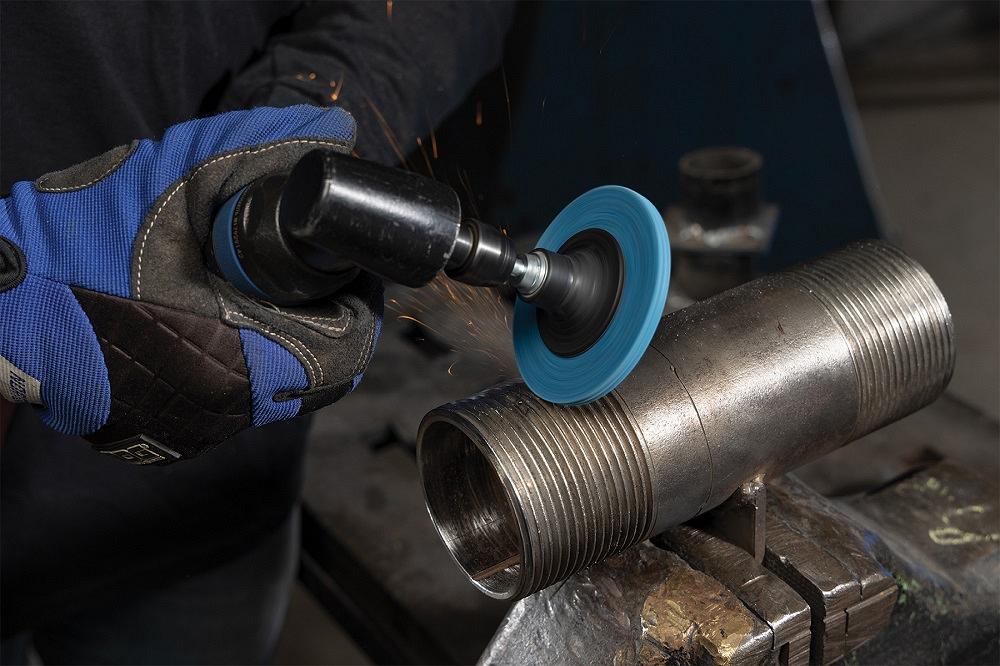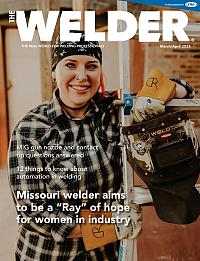Editor
- FMA
- The Fabricator
- FABTECH
- Canadian Metalworking
Categories
- Additive Manufacturing
- Aluminum Welding
- Arc Welding
- Assembly and Joining
- Automation and Robotics
- Bending and Forming
- Consumables
- Cutting and Weld Prep
- Electric Vehicles
- En Español
- Finishing
- Hydroforming
- Laser Cutting
- Laser Welding
- Machining
- Manufacturing Software
- Materials Handling
- Metals/Materials
- Oxyfuel Cutting
- Plasma Cutting
- Power Tools
- Punching and Other Holemaking
- Roll Forming
- Safety
- Sawing
- Shearing
- Shop Management
- Testing and Measuring
- Tube and Pipe Fabrication
- Tube and Pipe Production
- Waterjet Cutting
Industry Directory
Webcasts
Podcasts
FAB 40
Advertise
Subscribe
Account Login
Search
What metal fabricators need to know about nonwoven abrasives
Reduce the number of finishing steps, save time and money, improve quality, and reduce scrap rates
- By Rafael Guerrero
- March 23, 2023
- Article
- Finishing

Advancements in nonwoven abrasives technology have made it possible for fabricators to reduce the number of finishing steps, save time and money, improve quality, and reduce scrap rates. Images: Norton | Saint-Gobain Abrasives
Shops in need of an optimal finish typically look to nonwoven abrasives as their top choice.
The term nonwoven originates from the fact these abrasives are made from a web of nylon fibers infused with abrasive grains and bonded with resins, not woven together.
“When you turn a doorknob or use a stainless steel sink, how does that feel or look?” asks Michael Radaelli, senior product manager for Norton | Saint-Gobain Abrasives. The finish could likely be a result of “nonwoven types of abrasive products,” he added.
Nonwoven abrasives can prove advantageous to welders and fabricators in several ways. Depending on the product, nonwoven abrasives offer a consistent, uniform finish; reduce the risk of part gouging; make automating operations accessible; minimize smearing; and generally, are a more user-friendly option for new operators. They also minimize vibration and chatter, which helps operators maneuver the tool on difficult-to-finish parts.
The abrasive tends to cut smoothly, which gives users better control of the process. Not only can better control yield higher-quality surface finishes during hand-held grinding and polishing operations, but it also increases operator safety. Excessive vibration can cause damage to an operator’s vascular, sensory, or musculoskeletal system. Smooth, ergonomic abrasive products can help reduce those risks and increase operator safety and comfort for offhand processes.
Nonwoven abrasives may be identified as a valuable tool in welding and metal fabrication, but the use of these products can be found in other industries including heavy machinery, aerospace, automotive, and even medical prostheses and equipment.
“There are many products that are in some way finished by nonwoven abrasives,” Radaelli said.
Embracing Advancements
The advancements made in nonwoven abrasives technology have helped fabricators reduce the number of finishing steps, save time and money, improve quality, and reduce scrap rates.
The Vortex line of nonwoven abrasive products from Norton | Saint-Gobain turn coarse-grit abrasives grain into fine-finishing tools. Radaelli said the grain used in the Vortex Rapid Blend coarse-grit wheels and discs acts like “little abrasives” when bonded together, creating hundreds of cutting points.
"Because you have all these cutting points, it gives you a high cut rate,” he added. “You get all these tiny cutting points together and because they’re tiny, they leave a very good finish.”

The term nonwoven originates from the fact these abrasives are made from a web of nylon fibers infused with abrasive grains and bonded with resins, not woven together. These products have become a go-to choice for shops seeking an optimal finish.
Essentially, Radaelli said, it “cuts like a coarse abrasive, meaning it can remove material like a coarse-grit abrasive but finishes like a fine [grit]. So, it allows you to skip steps.”
In one example, this coarse-grit technology reduced a weld’s finish from a surface roughness average (Ra) of 100 to 70 Ra in one step. Surface roughness, or surface finish, is determined with a profilometer, a tool that measures a surface’s Ra by measuring the depth of a scratch within that material. The lower the Ra, the better the surface finish.
Continuing the operation with a Vortex medium-grit abrasive reduced the Ra from 70 to 30. In total, just two steps were necessary when traditionally, it would have required five or six steps.
This new coarse-grit, nonwoven technology is an extension of the Norton Vortex Rapid Blend line, and the new wheels and discs are available in densities ranging from high to low, depending on the application.
Radaelli recalled another example involving a customer who experienced control issues while using a bonded abrasive wheel to blend a part.
“When he put on the nonwoven product, it was easy to control. It took a little longer to get the weld down, but the finish was excellent and eliminated the need for a second finishing step.”
Don’t Overlook New Finishing Technologies
Radaelli said customers can sometimes overlook new technologies and process recommendations when determining their abrasives needs.
“A shop may not know what is available or may have a procedure in place where they write up a process sheet identifying what can or cannot be used,” he said. New grains and resins developed by research and development departments can help shops skip process steps and save time and money. They also can help shops identify which types of abrasives work best for specific applications.
For example, nonwoven should not be used in applications that require a lot of stock/material to be removed. While bonded abrasives are the slowest at stock removal, they have the longest product life. “If you’re an operator whose entire job is to remove material all day, that’s probably the product of choice,” Radaelli said. Coated abrasives, meanwhile, have the fastest stock removal but offer a mid-range product life.
“Nonwoven [abrasives] won’t have the speed of cut that a coated flap disc has, but the advantage they have is the best finish and [they] present no risk to damaging the part,” Radaelli added.
Some abrasives companies can help fabricators find or establish optimal grinding or finishing systems. This can lead to process changes such as switching from manual grinding to robotic grinding.
“There’s more than one way to build a mousetrap, as they say. There are typically alternative ways to finish the job. What often gets overlooked are new technologies,” Radaelli said.
About the Author

Rafael Guerrero
2135 Point Blvd.
Elgin, IL 60123
(815)-227-8242
Rafael Guerrero. was named editor of The Welder in April 2022. He spent nine years as a journalist in newspapers in the Midwest and Pacific Northwest, covering topics and communities in central Illinois, Washington, and the Chicago area.
About the Publication
Related Companies
subscribe now

The Welder, formerly known as Practical Welding Today, is a showcase of the real people who make the products we use and work with every day. This magazine has served the welding community in North America well for more than 20 years.
start your free subscription- Stay connected from anywhere

Easily access valuable industry resources now with full access to the digital edition of The Fabricator.

Easily access valuable industry resources now with full access to the digital edition of The Welder.

Easily access valuable industry resources now with full access to the digital edition of The Tube and Pipe Journal.
- Podcasting
- Podcast:
- The Fabricator Podcast
- Published:
- 04/16/2024
- Running Time:
- 63:29
In this episode of The Fabricator Podcast, Caleb Chamberlain, co-founder and CEO of OSH Cut, discusses his company’s...
- Industry Events
16th Annual Safety Conference
- April 30 - May 1, 2024
- Elgin,
Pipe and Tube Conference
- May 21 - 22, 2024
- Omaha, NE
World-Class Roll Forming Workshop
- June 5 - 6, 2024
- Louisville, KY
Advanced Laser Application Workshop
- June 25 - 27, 2024
- Novi, MI































